The ultimate guide to medicinal mushrooms
Medicinal mushrooms have long been used in Eastern medicine to promote healing, enhance immunity, and aid in digestion, but just how effective are they? From chaga to reishi, here’s how you can get in tune with the power of mushrooms.
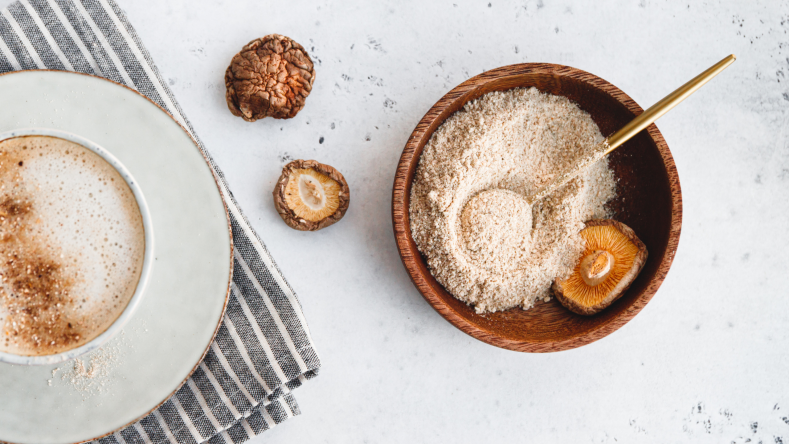
Medicinal mushrooms have been making waves lately, but if the thought of using mushrooms turns you off, science may be enough to change your mind. These fungi have incredible health benefits beyond reducing stress levels, and while they aren’t a cure-all for what ails you, they might be a supportive sidekick for your immune system. But what are medicinal mushrooms, where can you find them, and do they live up to the hype? From health benefits to dosing recommendations and precautions, here’s everything you need to know about medicinal mushrooms.
What are medicinal mushrooms?
Medicinal mushrooms are fungi that offer powerful health benefits, such as improved cognition better sleep quality reduced inflammation LDL (“bad”) cholesterol 1
Where to find medicinal mushrooms
Medicinal mushrooms can be taken as a powder, an extract, or in their natural state. While many people enjoy adding them to beverages (like tea, juice, smoothies, or coffee), you can also mix them into stir-fries, soups, ice cream, or yogurt.
Additionally, you can consume these fungi through supplements. While you can purchase them individually, navigating the supplement aisle can be tricky as there are numerous types of medicinal mushrooms, each with its unique benefits. At Elo Health, we take the guesswork out of the equation by overlaying your blood biomarker results, wearable data, and questionnaire answers to recommend the right nutrition and supplements for you.
While medicinal mushrooms may provide benefits, they aren’t a magic cure-all for your ailments and should be used under supervision from a healthcare professional (especially if you’re pregnant or taking other medications).
Types of medicinal mushrooms
Whether you’re looking to improve sleep, boost mental health, reduce inflammation, or enhance athletic performance, research suggests that medicinal mushrooms can offer some impressive benefits. From maitake to turkey tail, here’s everything you need to know about the most common types of medicinal mushrooms.

Reishi
Found in various humid locations throughout Asia, the reishi mushroom (Ganoderma lucidum) has long been used in Eastern medicine to promote health and longevity [ 2
Benefits of reishi mushroom
Reishi mushrooms have a compound called triterpene that has been found to improve sleep, reduce stress, alleviate anxiety, and ease depression [ 3 4 5 6 7 8
Dosage recommendations
The amount you take will depend on the form you choose, so you should check the label of each product for the recommended dose [ 9 10
There is no specific dosing information for this fungi, so talk with your healthcare provider to find which dose works best for you and your needs.
Precautions
Despite reishi’s popularity, the powdered form comes with a caution sign, as a major side effect includes liver toxicity [ 11 12
You should also avoid taking reishi if you are pregnant or breastfeeding, have a blood disorder, will be undergoing surgery or have low blood pressure [ 13
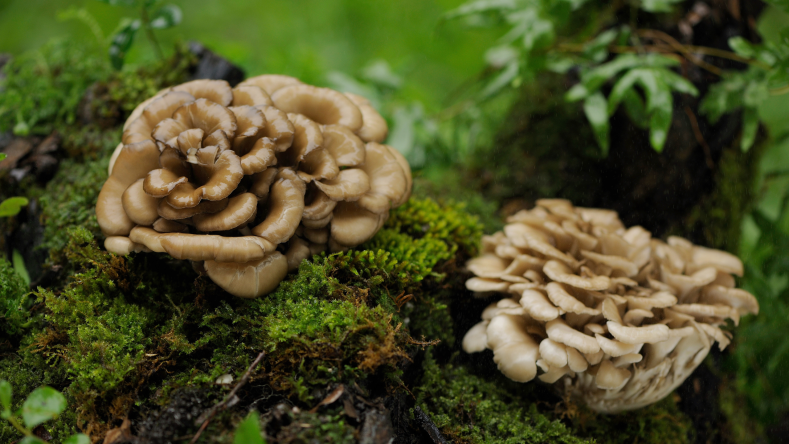
Maitake
Maitake mushrooms (Grifola frondose) naturally grow in parts of Japan, China, and North America during the autumn months. This fungus has been used for centuries in Eastern medicine to promote immune function, aid digestion, and facilitate weight management, but it’s only become popular in the United States over the past few decades.
Maitake mushroom benefits
Research suggests that maitake mushrooms might play a role in a healthy immune function, cancer prevention, stress levels, lowered cholesterol levels, and improved blood sugar levels [ 14 15 16 17
Moreover, maitake mushrooms are rich in antioxidants, beta-glucans, amino acids, and a plethora of vitamins and minerals (like vitamins B and C, copper, potassium, and fiber) [ 18
Dosing recommendations
You can find maitake mushrooms in their natural state and liquid concentrate or capsule form. If you settle on a supplement, look for maitake D-fraction, an extract of the fungi.
The dosage depends on your age, weight, height, and strength of the supplement. As such, you should carefully read the label instructions before taking it.
Precautions
Studies show that maitake mushroom extracts may interact with warfarin and should be taken with caution [ 19
Additionally, this fungi hasn't been shown to be fully safe for those who are pregnant, breastfeeding, or have diabetes, an autoimmune disease, or mold sensitivity, so it’s recommended that you check with a doctor before use.

Turkey tail
Turkey tail mushrooms (Coriolus versicolor) is a multicolored fungus that grows on tree trunks and fallen trees in wooded areas worldwide. It’s been used in traditional Chinese medicine to treat lung diseases and has steadily gained popularity in the United States [ 31
Turkey tail mushroom benefits
Thanks to the compound polysaccharide-K (PSK), turkey tail mushrooms have a high antioxidant content, offer anti-cancer properties, and may improve the immune system of those receiving chemotherapy [ 20
Studies have also shown it to balance gut bacteria, improve insulin resistance, reduce inflammation, and even boost athletic performance [ 21 22 23 24
Dosing recommendations
Turkey tail extract is available in powder or tea, but additional research is needed to determine dosage. If you choose to take this fungus, follow the dosage instructions on the product label and do not take more than it recommends.
Precautions
While severe side effects haven’t been associated with turkey tail, some have reported mild effects like heartburn, constipation, nausea, or flu-like symptoms. If you have a mushroom or mold allergy, you should not take turkey tail, as this may cause a severe reaction. Talk with your healthcare provider before adding turkey tail into your supplement routine.
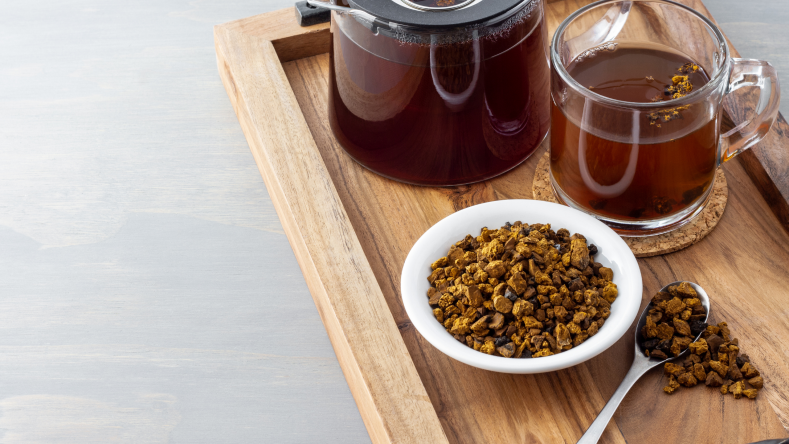
Chaga
Chaga mushrooms (Inonotus obliquus) mainly grow on the bark of birch trees in cold climates and have long been used in Siberia and other parts of Asia to boost immunity and improve overall health [ 24
Chaga mushroom benefits
Studies show that chaga mushrooms are packed full of antioxidants that can help with oxidative stress and inflammation [ 25 26 27
Additionally, these fungi may play a role in cancer prevention. For example, researchers have found that people who took a chaga supplement experienced a 60% reduction in tumor size compared to those who didn’t take chaga [ 28 29
Dosing recommendations
You can find this fungus in chaga mushroom tea or in supplement form, but more research is needed to determine the optimal dosage. As such, it’s recommended to follow dosing instructions on the product label.
Precautions
Studies show that chaga contains a protein that might prevent blood clotting. If you are on blood thinners, have a bleeding disorder, or are preparing for surgery, consult with your healthcare provider before taking this supplement [ 30
Chaga may also pose a risk to those who take insulin or have diabetes. Since there is no research on pregnant or breastfeeding women, it’s recommended for this population to avoid supplementation.
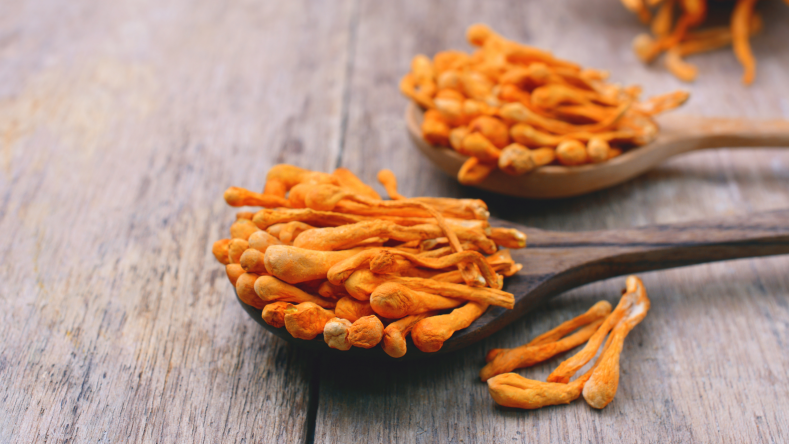
Cordyceps
There are over 400 cordyceps species, many of which are native to China, Korea, Nepal, Thailand, and Vietnam. The most well-known medicinal species is Cordyceps sinensis, which has long been used in Eastern medicine to improve appetite, stamina, libido, endurance, and sleep [ 32
Cordyceps mushroom benefits
Research shows that Cordyceps sinensis can boost energy, help enhance blood and oxygen flow, increase ATP (energy) production, and improve post-workout recovery [ 33 34 35
Additionally, Cordyceps sinensis may potentially treat certain cancers, manage type 2 diabetes, and reduce inflammation, but more research is needed to determine this [ 36 37 38
Dosing recommendations
You can find this fungus as a cordyceps supplement (via capsule, tablet, or powder formulations), or in its dried, whole form with tinctures and extracts.
While there are no dosing recommendations, it’s suggested to take the amount specified on the product label.
Precautions
Even though cordyceps are generally considered safe for short-term use, mild side effects like stomach ache, nausea, diarrhea, or dry mouth have been reported, but this usually resolves once supplementation stops [ 39
Those who have diabetes, bleeding disorders, take blood thinners, are pregnant or breastfeeding, or have a mold or yeast allergy should avoid cordyceps.
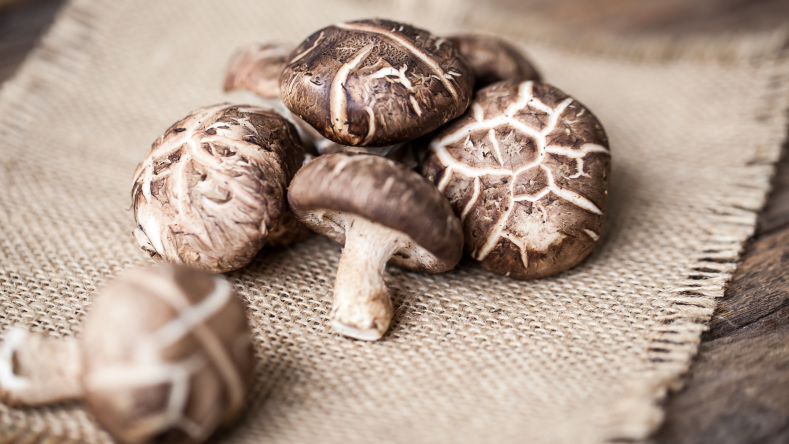
Shiitake
Shiitake mushrooms are one of the most popular varieties worldwide and can be enjoyed fresh, dried, or in various supplement forms. Interestingly, these mushrooms contain many of the same amino acids as meat, making them a popular choice for vegetarians and vegans alike [ 40
Shiitake mushrooms are also rich in vitamins and minerals, including copper (an essential mineral needed for iron metabolism, bones, and immune support) [ 43
Shiitake mushroom benefits
Research shows that shiitake mushrooms may offer major heart health benefits, as they can help lower LDL cholesterol, improve circulation, reduce inflammation, and prevent plaque buildup in the arteries [ 41
They may also play a role in immunity, as one study found that people who consumed two dried shiitakes each day experienced a decrease in inflammation and an increase in immune markers [ 42
Dosing recommendations
While you can enjoy shiitake mushrooms as fresh or dried, they’re also available as a supplement in capsule or powder form, which you can add to teas, smoothies, or soup broth. A supplement can contain the equivalent of 3 to 8 mushrooms, which may sound like a lot, but it’s generally considered safe in this amount. However, it’s recommended to talk with a healthcare professional to determine an appropriate dose.
Precautions
Shiitake mushrooms are generally well-tolerated, but some have reported skin rashes, digestive problems, and increased sensitivity to sunlight [ 44 45

Lion's mane
Lion’s mane (Yamabushitake) gets its name from the white, shaggy hairs that grow on the mushroom. Countries throughout Asia have used lion’s mane mushroom for culinary and medicinal purposes since it’s thought to benefit the brain, gut, and heart.
Lion's mane benefits
Science suggests that lion’s mane may be beneficial for mental clarity, thanks to its positive impact on cognition, memory, and concentration [ 46 47 46
Additionally, lion’s mane mushroom has been shown to protect against ulcers, reduce the risk of heart disease, manage diabetes symptoms, and reduce inflammation [ 48 49 50 51
Dosing recommendations
Lion’s mane mushrooms can be enjoyed raw, dried, or steeped in tea. You can also find a lion's mane supplement, lion’s mane coffee, and lion’s mane powder sold in many stores. Lion’s mane supplements vary in potency so check the label for product-specific dosing recommendations before taking.
Precautions
Lion’s mane mushroom appears to be relatively safe with little to no side effects, but those who are allergic or sensitive to mushrooms should steer clear to avoid unwanted reactions.
Summary
Medicinal mushrooms have been used in Eastern medicine for centuries. Emerging research suggests that these fungi might live up to the hype as they become more mainstream in Western society. Studies show that medicinal mushrooms can greatly benefit sleep, mental health, blood sugar levels, athletic performance, and cancer prevention. While they aren’t a cure-all for what ails you, they might be a nice sidekick for your immune system. However, they may have some unwanted side effects, so talk with a healthcare provider before taking medicinal mushrooms to determine what dosage (if any) works best for you.
Disclaimer: The text, images, videos, and other media on this page are provided for informational purposes only and are not intended to treat, diagnose or replace personalized medical care.
Key takeaways
Medicinal mushrooms are fungi that offer powerful health benefits, such as improved cognition, better sleep quality, reduced inflammation, and lower LDL (“bad”) cholesterol.
Medicinal mushrooms can be found as a powder, an extract, or in their natural state.
Reishi, chaga, shiitake, lion’s man, cordyceps, maitake, and turkey tail are some of the most common types of medicinal mushrooms.
Medicinal mushrooms may have some unwanted side effects, so it’s recommended to talk with a healthcare provider before taking them to determine what dosage (if any) works best for you.
References:
Medicinal mushroom. Medicinal Mushroom - an overview | ScienceDirect Topics. (n.d.). Retrieved May 26, 2022, from
https://www.sciencedirect.com/topics/biochemistry-genetics-and-molecular-biology/medicinal-mushroom
Ganoderma lucidum (Lingzhi or reishi) - herbal medicine - NCBI bookshelf. (n.d.). Retrieved May 26, 2022, from
https://www.ncbi.nlm.nih.gov/books/NBK92757/
Venturella, G., Ferraro, V., Cirlincione, F., & Gargano, M. L. (2021). Medicinal Mushrooms: Bioactive Compounds, Use, and Clinical Trials. International journal of molecular sciences, 22(2), 634.
https://doi.org/10.3390/ijms22020634
Pazzi, F., Adsuar, J. C., Domínguez-Muñoz, F. J., García-Gordillo, M. A., Gusi, N., & Collado-Mateo, D. (2020). Ganoderma lucidum Effects on Mood and Health-Related Quality of Life in Women with Fibromyalgia. Healthcare (Basel, Switzerland), 8(4), 520.
https://doi.org/10.3390/healthcare8040520
Lin Z. B. (2005). Cellular and molecular mechanisms of immuno-modulation by Ganoderma lucidum. Journal of pharmacological sciences, 99(2), 144–153.
https://doi.org/10.1254/jphs.crj05008x
Sliva D. Ganoderma lucidum (Reishi) in cancer treatment. Integr Cancer Ther. 2003 Dec;2(4):358-64. doi: 10.1177/1534735403259066.
Chu TT, Benzie IF, Lam CW, Fok BS, Lee KK, Tomlinson B. Study of potential cardioprotective effects of Ganoderma lucidum (Lingzhi): results of a controlled human intervention trial. Br J Nutr. 2012 Apr;107(7):1017-27. doi: 10.1017/S0007114511003795.
Gao, Y., Lan, J., Dai, X., Ye, J., & Zhou, S. (2004). A phase I/II study of Ling Zhi Mushroom Ganoderma lucidum (W.Curt.:Fr.)Lloyd (Aphyllophoromycetideae) extract in patients with type II diabetes mellitus. International Journal of Medicinal Mushrooms, 6(1), 8.
https://doi.org/10.1615/intjmedmushr.v6.i1.30
Examine.com. (2022, January 10). Ganoderma lucidum supplement - health benefits, dosage, side effects. Examine.com. Retrieved May 26, 2022, from
https://examine.com/supplements/ganoderma-lucidum/
Klupp, N. L., Chang, D., Hawke, F., Kiat, H., Cao, H., Grant, S. J., & Bensoussan, A. (2015). Ganoderma lucidum mushroom for the treatment of cardiovascular risk factors. The Cochrane database of systematic reviews, 2015(2), CD007259.
https://doi.org/10.1002/14651858.CD007259.pub2
Wanmuang, H., Leopairut, J., Kositchaiwat, C., Wananukul, W., & Bunyaratvej, S. (2007). Fatal fulminant hepatitis associated with Ganoderma lucidum (Lingzhi) mushroom powder. Journal of the Medical Association of Thailand = Chotmaihet thangphaet, 90(1), 179–181.
Jin X, Ruiz Beguerie J, Sze DM, Chan GC. Ganoderma lucidum (Reishi mushroom) for cancer treatment. Cochrane Database Syst Rev. 2016 Apr 5;4(4):CD007731. doi: 10.1002/14651858.CD007731.pub3.
U.S. National Library of Medicine. (n.d.). Reishi Mushroom: Medlineplus supplements. MedlinePlus. Retrieved May 26, 2022, from
https://medlineplus.gov/druginfo/natural/905.html
Guggenheim, A. G., Wright, K. M., & Zwickey, H. L. (2014). Immune Modulation From Five Major Mushrooms: Application to Integrative Oncology. Integrative medicine (Encinitas, Calif.), 13(1), 32–44.
Alonso, E. N., Orozco, M., Nieto, A. E., & Balogh, G. A. (2013). Genes related to suppression of malignant phenotype induced by Maitake D-fraction in breast cancer cells. Journal of Medicinal Food, 16(7), 602–617.
https://doi.org/10.1089/jmf.2012.0222
Sato, M., Tokuji, Y., Yoneyama, S., Fujii-Akiyama, K., Kinoshita, M., Chiji, H., & Ohnishi, M. (2013). Effect of dietary maitake (grifola frondosa) mushrooms on plasma cholesterol and hepatic gene expression in cholesterol-fed mice. Journal of Oleo Science, 62(12), 1049–1058.
https://doi.org/10.5650/jos.62.1049
Chen, Y. H., Lee, C. H., Hsu, T. H., & Lo, H. C. (2015). Submerged-Culture Mycelia and Broth of the Maitake Medicinal Mushroom Grifola frondosa (Higher Basidiomycetes) Alleviate Type 2 Diabetes-Induced Alterations in Immunocytic Function. International journal of medicinal mushrooms, 17(6), 541–556.
https://doi.org/10.1615/intjmedmushrooms.v17.i6.50
Valverde, M. E., Hernández-Pérez, T., & Paredes-López, O. (2015). Edible mushrooms: improving human health and promoting quality life. International journal of microbiology, 2015, 376387.
https://doi.org/10.1155/2015/376387
Hanselin, M. R., Vande Griend, J. P., & Linnebur, S. A. (2010). INR elevation with Maitake extract in combination with warfarin. Annals of Pharmacotherapy, 44(1), 223–224.
https://doi.org/10.1345/aph.1m510
Krestin. Krestin - an overview | ScienceDirect Topics. (n.d.). Retrieved May 26, 2022, from
https://www.sciencedirect.com/topics/medicine-and-dentistry/krestin
Pallav, K., Dowd, S. E., Villafuerte, J., Yang, X., Kabbani, T., Hansen, J., Dennis, M., Leffler, D. A., Newburg, D. S., & Kelly, C. P. (2014). Effects of polysaccharopeptide from Trametes Versicolor and amoxicillin on the gut microbiome of healthy volunteers. Gut Microbes, 5(4), 458–467.
https://doi.org/10.4161/gmic.29558
Arulselvan, P., Fard, M. T., Tan, W. S., Gothai, S., Fakurazi, S., Norhaizan, M. E., & Kumar, S. S. (2016). Role of Antioxidants and Natural Products in Inflammation. Oxidative medicine and cellular longevity, 2016, 5276130.
https://doi.org/10.1155/2016/5276130
Ho, C. S., Tung, Y. T., Kung, W. M., Huang, W. C., Leung, W. K., Huang, C. C., & Wu, J. H. (2017). Effect of Coriolus versicolor Mycelia Extract on Exercise Performance and Physical Fatigue in Mice. International journal of medical sciences, 14(11), 1110–1117.
https://doi.org/10.7150/ijms.20547
Shashkina, M. Y., Shashkin, P. N., & Sergeev, A. V. (2006). Chemical and medicobiological properties of chaga (review). Pharmaceutical Chemistry Journal, 40(10), 560–568.
https://doi.org/10.1007/s11094-006-0194-4
Najafzadeh, M., Reynolds, P. D., Baumgartner, A., Jerwood, D., & Anderson, D. (2007). Chaga mushroom extract inhibits oxidative DNA damage in lymphocytes of patients with inflammatory bowel disease. BioFactors (Oxford, England), 31(3-4), 191–200.
https://doi.org/10.1002/biof.5520310306
Javed, S., Mitchell, K., Sidsworth, D., Sellers, S. L., Reutens-Hernandez, J., Massicotte, H. B., Egger, K. N., Lee, C. H., & Payne, G. W. (2019). Inonotus obliquus attenuates histamine-induced microvascular inflammation. PloS one, 14(8), e0220776.
https://doi.org/10.1371/journal.pone.0220776
Liang, L., Zhang, Z., Sun, W., & Wang, Y. (2009). Effect of the inonotus obliquus polysaccharides on blood lipid metabolism and oxidative stress of rats fed high-fat diet in vivo. 2009 2nd International Conference on Biomedical Engineering and Informatics.
https://doi.org/10.1109/bmei.2009.5305591
Arata, S., Watanabe, J., Maeda, M., Yamamoto, M., Matsuhashi, H., Mochizuki, M., Kagami, N., Honda, K., & Inagaki, M. (2016). Continuous intake of the Chaga mushroom (Inonotus obliquus) aqueous extract suppresses cancer progression and maintains body temperature in mice. Heliyon, 2(5), e00111.
https://doi.org/10.1016/j.heliyon.2016.e00111
Youn, M. J., Kim, J. K., Park, S. Y., Kim, Y., Kim, S. J., Lee, J. S., Chai, K. Y., Kim, H. J., Cui, M. X., So, H. S., Kim, K. Y., & Park, R. (2008). Chaga mushroom (Inonotus obliquus) induces G0/G1 arrest and apoptosis in human hepatoma HepG2 cells. World journal of gastroenterology, 14(4), 511–517.
https://doi.org/10.3748/wjg.14.511
Hyun, K. W., Jeong, S. C., Lee, D. H., Park, J. S., & Lee, J. S. (2006). Isolation and characterization of a novel platelet aggregation inhibitory peptide from the medicinal mushroom, Inonotus obliquus. Peptides, 27(6), 1173–1178.
https://doi.org/10.1016/j.peptides.2005.10.005
Medicinal mushrooms (PDQ®) - PDQ cancer information summaries - NCBI ... (n.d.). Retrieved May 26, 2022, from
https://www.ncbi.nlm.nih.gov/books/NBK424937/
Panda, A. K., & Swain, K. C. (2011). Traditional uses and medicinal potential of Cordyceps sinensis of Sikkim. Journal of Ayurveda and integrative medicine, 2(1), 9–13.
https://doi.org/10.4103/0975-9476.78183
Tuli, H. S., Sandhu, S. S., & Sharma, A. K. (2013). Pharmacological and therapeutic potential of cordyceps with special reference to Cordycepin. 3 Biotech, 4(1), 1–12.
https://doi.org/10.1007/s13205-013-0121-9
Chen, C.-Y., Hou, C.-W., Bernard, J. R., Chen, C.-C., Hung, T.-C., Cheng, L.-L., Liao, Y.-H., & Kuo, C.-H. (2014). Rhodiola crenulata- and Cordyceps sinensis-Based Supplement Boosts Aerobic Exercise Performance after Short-Term High Altitude Training. High Altitude Medicine & Biology, 15(3), 371–379.
https://doi.org/10.1089/ham.2013.1114
Yi, X., Xi-zhen, H., & Jia-shi, Z. (2004). Randomized double-blind placebo-controlled clinical trial and assessment of fermentation product of cordyceps sinensis (CS-4) in enhancing aerobic capacity and respiratory function of the healthy elderly volunteers. Chinese Journal of Integrative Medicine, 10(3), 187–192.
https://doi.org/10.1007/bf02836405
Bizarro, A., Ferreira, I. C., Soković, M., van Griensven, L. J., Sousa, D., Vasconcelos, M. H., & Lima, R. T. (2015). Cordyceps militaris (L.) Link Fruiting Body Reduces the Growth of a Non-Small Cell Lung Cancer Cell Line by Increasing Cellular Levels of p53 and p21. Molecules (Basel, Switzerland), 20(8), 13927–13940.
https://doi.org/10.3390/molecules200813927
Lo, H. C., Tu, S. T., Lin, K. C., & Lin, S. C. (2004). The anti-hyperglycemic activity of the fruiting body of Cordyceps in diabetic rats induced by nicotinamide and streptozotocin. Life sciences, 74(23), 2897–2908.
https://doi.org/10.1016/j.lfs.2003.11.003
Park, S. Y., Jung, S. J., Ha, K. C., Sin, H. S., Jang, S. H., Chae, H. J., & Chae, S. W. (2015). Anti-inflammatory effects of Cordyceps mycelium (Paecilomyces hepiali, CBG-CS-2) in Raw264.7 murine macrophages. Oriental pharmacy and experimental medicine, 15(1), 7–12.
https://doi.org/10.1007/s13596-014-0173-3
Tuli, H. S., Sandhu, S. S., & Sharma, A. K. (2013). Pharmacological and therapeutic potential of cordyceps with special reference to Cordycepin. 3 Biotech, 4(1), 1–12.
https://doi.org/10.1007/s13205-013-0121-9
Guillamón, E., García-Lafuente, A., Lozano, M., D´Arrigo, M., Rostagno, M. A., Villares, A., & Martínez, J. A. (2010). Edible mushrooms: Role in the Prevention of Cardiovascular Diseases. Fitoterapia, 81(7), 715–723.
https://doi.org/10.1016/j.fitote.2010.06.005
Yu, S., Weaver, V., Martin, K., & Cantorna, M. T. (2009). The effects of whole mushrooms during inflammation. BMC Immunology, 10(1).
https://doi.org/10.1186/1471-2172-10-12
Dai, X., Stanilka, J. M., Rowe, C. A., Esteves, E. A., Nieves, C., Jr, Spaiser, S. J., Christman, M. C., Langkamp-Henken, B., & Percival, S. S. (2015). Consuming Lentinula edodes (Shiitake) Mushrooms Daily Improves Human Immunity: A Randomized Dietary Intervention in Healthy Young Adults. Journal of the American College of Nutrition, 34(6), 478–487.
https://doi.org/10.1080/07315724.2014.950391
U.S. Department of Health and Human Services. (n.d.). Office of dietary supplements - copper. NIH Office of Dietary Supplements. Retrieved May 27, 2022, from
https://ods.od.nih.gov/factsheets/Copper-HealthProfessional/
Stephany, M. P., Chung, S., Handler, M. Z., Handler, N. S., Handler, G. A., & Schwartz, R. A. (2016). Shiitake Mushroom Dermatitis: A Review. American journal of clinical dermatology, 17(5), 485–489.
https://doi.org/10.1007/s40257-016-0212-6
Czarnecka, A. B., Kreft, B., & Marsch, W. (2014). Flagellate dermatitis after consumption of Shiitake mushrooms. Postepy dermatologii i alergologii, 31(3), 187–190.
https://doi.org/10.5114/pdia.2014.40929
Mori, K., Inatomi, S., Ouchi, K., Azumi, Y., & Tuchida, T. (2009). Improving effects of the mushroom Yamabushitake (Hericium erinaceus) on mild cognitive impairment: a double-blind placebo-controlled clinical trial. Phytotherapy Research, 23(3), 367–372.
https://doi.org/10.1002/ptr.2634
Sabaratnam, V., Kah-Hui, W., Naidu, M., & Rosie David, P. (2013). Neuronal health - can culinary and medicinal mushrooms help?. Journal of traditional and complementary medicine, 3(1), 62–68.
https://doi.org/10.4103/2225-4110.106549
Qin, M., Geng, Y., Lu, Z., Xu, H., Shi, J. S., Xu, X., & Xu, Z. H. (2016). Anti-Inflammatory Effects of Ethanol Extract of Lion's Mane Medicinal Mushroom, Hericium erinaceus (Agaricomycetes), in Mice with Ulcerative Colitis. International journal of medicinal mushrooms, 18(3), 227–234.
https://doi.org/10.1615/IntJMedMushrooms.v18.i3.50
Mori, K., Kikuchi, H., Obara, Y., Iwashita, M., Azumi, Y., Kinugasa, S., Inatomi, S., Oshima, Y., & Nakahata, N. (2010). Inhibitory effect of hericenone B from Hericium erinaceus on collagen-induced platelet aggregation. Phytomedicine : international journal of phytotherapy and phytopharmacology, 17(14), 1082–1085.
https://doi.org/10.1016/j.phymed.2010.05.004
He, X., Wang, X., Fang, J., Chang, Y., Ning, N., Guo, H., Huang, L., Huang, X., & Zhao, Z. (2017). Structures, biological activities, and industrial applications of the polysaccharides from Hericium erinaceus (Lion's Mane) mushroom: A review. International journal of biological macromolecules, 97, 228–237.
https://doi.org/10.1016/j.ijbiomac.2017.01.040
Hou, Y., Ding, X., & Hou, W. (2015). Composition and antioxidant activity of water-soluble oligosaccharides from Hericium erinaceus. Molecular medicine reports, 11(5), 3794–3799.
https://doi.org/10.3892/mmr.2014.3121
